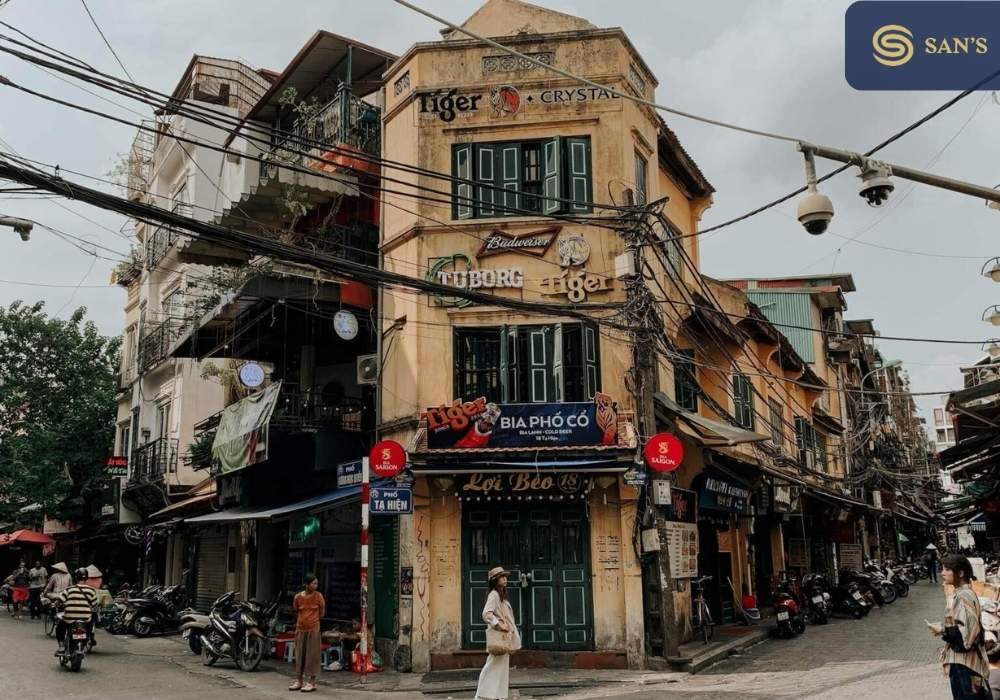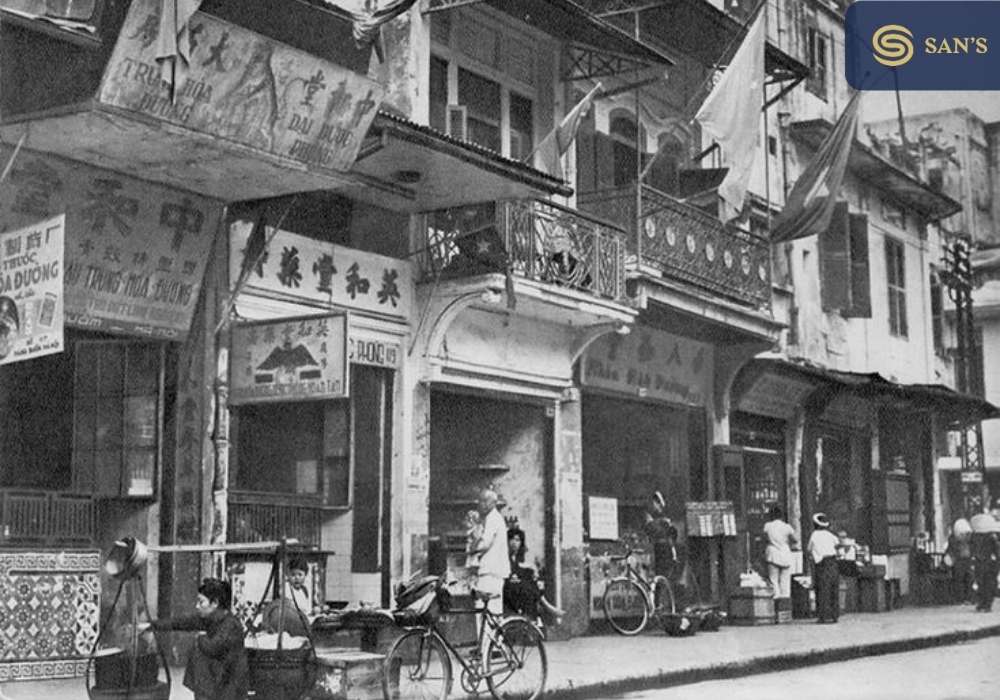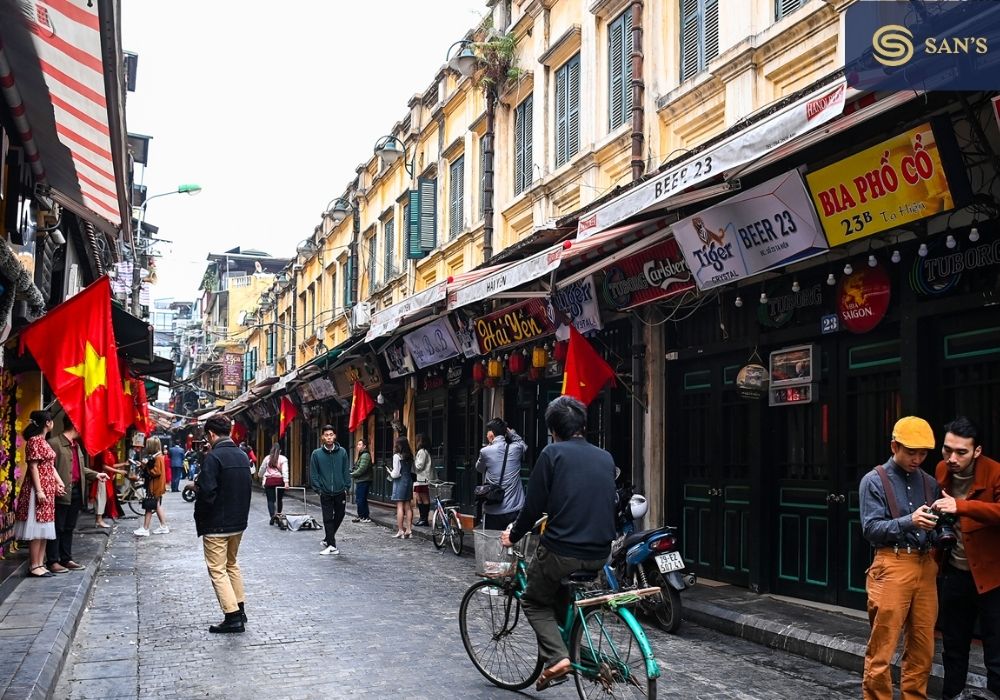In the heart of Hanoi, where the city’s lifeblood pulses strongest, you’ll find Hang Dau Street. This street is not merely a location on a map; it’s a living chronicle of the city’s past and present, a place where history, commerce, and culture intertwine to create a dynamic tableau reflective of Hanoi’s spirit.
At the Hanoi Old Quarter, the essence of the city’s heartbeat, Hang Dau stands out as a symbol of this vitality. It may initially present itself as a sanctuary for shoe shoppers, but Hang Dau is so much more than a series of storefronts. It tells a tale of evolution and endurance, a street that has become synonymous with the soul of Hanoi.

Hang Dau’s enchanting blend of traditional allure and modern zest makes it not merely a shopping street but a destination to be experienced. Wanderers and shoppers alike are called to walk its path, to uncover the street’s magic, to see for themselves what makes Hang Dau a jewel in the lively mosaic of Hanoi.
History of Hang Dau Street
Nestled within the bustling core of the city, Hang Dau Street’s story is one of transformation. Its origins, like the rings of a tree, tell of growth and change. It was once a part of the city where tradespeople of similar crafts would cluster, creating a vibrant community of skilled artisans.
But Hang Dau’s current reputation as a bustling shoe market didn’t happen overnight. The street evolved, as did the city around it. Initially a place of varied trade, the increasing demand for durable, stylish, and affordable footwear saw Hang Dau’s craftsmen pivoting to meet this need. Their skill in creating shoes that were both practical and aesthetically pleasing quickly garnered attention, drawing more shoemakers and buyers to the street, and cementing its status as a hub for quality footwear.
Hanoi Old Quarter in the Past
The growth of Hang Dau was not only a result of the craftsmen’s adaptability but also the broader societal changes. As Hanoi’s population burgeoned and fashion trends shifted towards Western styles, shoes transitioned from a mere necessity to a statement of style. Hang Dau’s strategic location and reputation for quality positioned it perfectly to meet these new demands.
The opening of Vietnam’s market brought tourists to Hang Dau, further expanding its clientele. The street adapted once more, offering not only Vietnamese designs but also catering to international tastes.

Today, Hang Dau Street stands as a vibrant testament to Hanoi’s rich history, its capacity for adaptation, and its enduring spirit.
Adjacent Streets & Connections
Hang Dau Street doesn’t exist in isolation; it’s part of a larger narrative. It connects with surrounding streets, each with its own identity but together forming a vibrant network within Hanoi’s urban landscape.
South of Hang Dau lies the enthralling Old Quarter, a place where history lives in every alley. Nearby Hang Be Street, with its bustling marketplace, offers a cornucopia of goods, from fresh foods to artisan crafts. It is a microcosm of the city’s gastronomic and craft heritage.
Running parallel to Hang Dau is Hang Bac Street, a centuries-old center for silversmiths. Here, the craftsmanship of Hanoi shines as brightly as the silver ornaments displayed in shop windows.
Hang Ma Street, known for its colorful paper goods, comes alive during festivals, showcasing Vietnam’s vibrant traditions.
>>> 5 things to do in Hanoi Old Quarter
Shopping Tips for First-time Visitors
For those new to Hang Dau Street’s lively atmosphere, here are some tips to help you navigate the area:
- Start early for a cooler, less crowded experience.
- Research beforehand to pinpoint must-visit shops.
- Dress comfortably for extensive walking.
- Bargain respectfully – it’s expected but should be done with a smile.
- Check the quality of goods thoroughly.
- Carry cash for easier transactions, especially in smaller shops.
- Stay hydrated and take breaks to enjoy local cafes.
- Keep an eye on your belongings in busy areas.
- Engage with locals for the best shopping advice and recommendations.

FAQs: Hang Dau Street, Hanoi
- What is Hang Dau Street famous for? Hang Dau is renowned for its extensive selection of footwear, from traditional Vietnamese styles to modern shoes.
- Where is Hang Dau Street located in Hanoi? Hang Dau Street is a prominent feature of Hanoi’s Old Quarter, known for its vibrant life and rich history.
- When is the best time to visit Hang Dau Street? The street is most vibrant in the early mornings and late afternoons.
- Is bargaining accepted on Hang Dau Street? Yes, bargaining is part of the shopping experience here, but it should be approached with respect.
- Are there other attractions or specialties nearby? Absolutely, Hang Dau is surrounded by streets like Hang Bac and Hang Ma, each known for their unique products.
- Is Hang Dau Street pedestrian-friendly? Yes, though it can get crowded, it is accessible to pedestrians.
- Are there eateries or cafes on Hang Dau Street? Yes, there’s a variety of local eateries and cafes around Hang Dau.
- Can I find vegan or vegetarian shoes on Hang Dau Street? Many shops now offer a range of options, including vegan shoes.
- How can I identify genuine handcrafted shoes? Look for craftsmanship details and don’t hesitate to ask the sellers about the production process.
- Is Hang Dau Street safe for tourists? Like most central areas in Hanoi, Hang Dau is generally safe for tourists.
Remember, a visit to Hang Dau Street is more than just a shopping trip; it’s a deep dive into the heart of Hanoi’s bustling culture and commerce. Whether you come for the shoes or simply to absorb the atmosphere, Hang Dau offers an unforgettable slice of city life.
Comment (0)